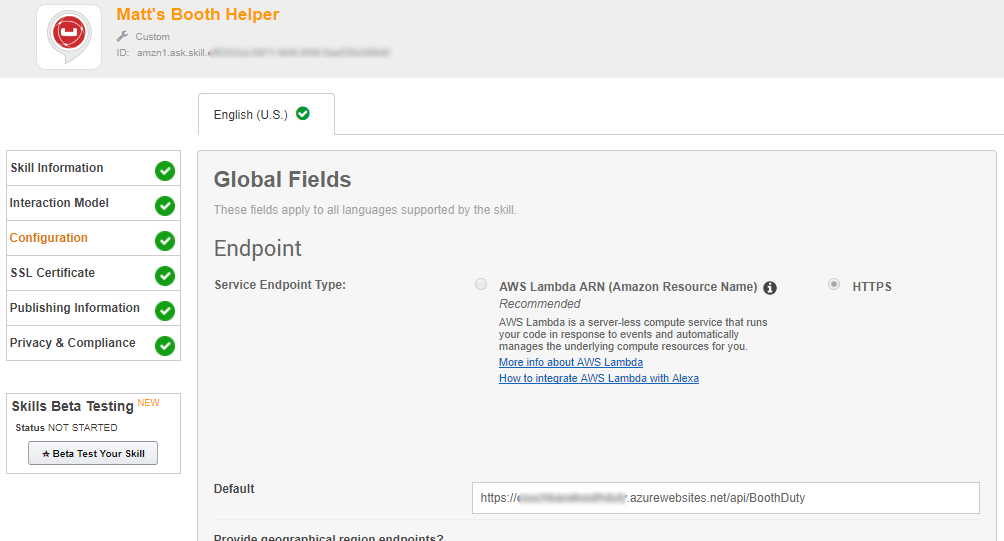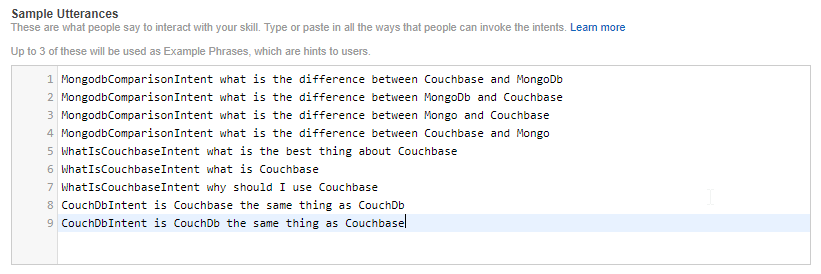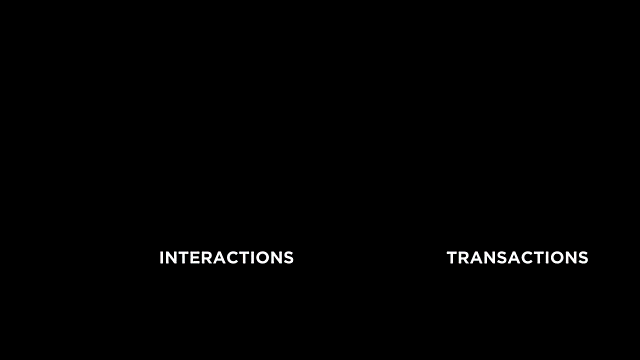SELECT m.*, META(m).id
FROM boothduty m
WHERE m.type = 'mongodbcomparison'
ORDER BY UUID()
LIMIT 1;This is a repost that originally appeared on the Couchbase Blog: Alexa Skills with Azure Functions and Couchbase.
Alexa Skills are the "apps" that you can build to run on Amazon devices like the Echo, Echo Dot, etc. In this blog post, you’ll learn how to build an Alexa skill using serverless Azure Functions and a Couchbase backend running on Azure. This post builds on a lot of blog posts I’ve written about Azure Functions, Serverless, and Couchbase on Azure in the past:
-
Serverless Architecture with Cloud Computing - What is serverless?
-
Azure Functions and Lazy Initialization with Couchbase Server - Recommendations when using Couchbase and Azure Functions together
-
Chatbot on Azure and Couchbase for Viber - A use case similar to an Alexa skill
-
Azure: Getting Started is Easy and Free - How to use the Azure Marketplace to easily create a Couchbase Cluster
What kind of Alexa skills am I building?
I work as a Developer Advocate, which means I often spend time at sponsor booths at developer events. I love doing this: I get to tell people how great Couchbase is, and I often get feedback from developers about what problems they’re trying to solve with Couchbase.
If there’s one thing I don’t like about working a booth, though, it’s repetition. I often get asked the same set of questions hundreds of times per events:
-
What is Couchbase? (distributed NoSQL document database with a memory first architecture)
-
How is Couchbase different than MongoDB? (they are both document databases, but Couchbase has major feature and architectural differences)
-
Is Couchbase the same thing as CouchDB? (No.)
I’m not complaining, mind you. It’s just that it’s hard to be enthusiastic when answering the question for the 100th time as the conference is about to close down.
But you know who is always enthusiastic? Alexa! So, if I bring my Echo Dot to the next event, maybe she can help me:
-
What is Couchbase? - Alexa will say a random interesting fact about Couchbase
-
How is Couchbase different than MongoDB? Alexa will say a random architectural or feature difference.
-
Is Couchbase the same thing as CouchDB? Alexa will say "no".
If these Alexa skills turn out to be helpful, I can expand the skills later to answer more complex questions.
If you want to follow along with this post and create your own Alexa skills, the full source code is available on Github.
Design
Alexa skills are registered with Amazon. For the most part, they make simple HTTP requests to the endpoint that you designate and expect a certain JSON response. Azure Functions can process HTTP requests. The Azure Functions can make queries out to a database full of responses, and can also keep track of how many times each response has been given.
Below is a high-level architectural diagram of my minimum viable Alexa skills project:

Data storage and design
The skill is going to ultimately query some data from Couchbase Server. I’ll start with 2 different kinds of documents. (If these Alexa skills turn out to be useful, I’ll add more complex stuff later).
Document design
Each document represents a possible response. Each will have 3 fields:
-
type- This will be either "mongodbcomparison" or "whatiscouchbase". -
number- The number of times this response has been used (starting at 0). -
text- The text that I want the Alexa skills to say.
The document key design of these documents is not important (at least not yet), since I’ll be using only N1QL (SQL for JSON) queries to retrieve them. However, I’ve decided to create keys like "mongo::2" and "couchbase::5".
To start, I will store this data in a single Couchbase node on a low cost Azure VM. A single node with a small amount of data should be able to handle even heavy booth traffic no problem. But if, for instance, I were to install these as kiosks in airports around the world I will definitely need to scale up my Couchbase cluster. Couchbase and Azure makes this easy.
Query design
To get a random document, I need to run a N1QL query:
UUID is functioning as a random number generator. That’s not really what it’s for, but it’s "good enough". If I really needed true randomness, I could make a curl request in N1QL to random.org’s API.
To run that query, I need to create an index for the 'type' field:
CREATE INDEX ix_type ON boothduty(type);Azure Functions
To create an Azure Function, I used an existing .NET library called AlexaSkills.NET, which makes it very easy to write the code you need to create Alexa skills.
After creating my Azure Functions solution, I added it with NuGet.
Using AlexaSkills.NET
Next, I created a "speechlet" class. I chose to make my speechlet asynchronous, but a synchronous option exists as well. There are four methods that need to be created. I only really need two of them for the skill at this point.
public class BoothDutySpeechlet : SpeechletBase, ISpeechletWithContextAsync
{
public async Task<SpeechletResponse> OnIntentAsync(IntentRequest intentRequest, Session session, Context context)
{
try
{
var intentName = intentRequest.Intent.Name;
var intentProcessor = IntentProcessor.Create(intentName);
return await intentProcessor.Execute(intentRequest);
}
catch (Exception ex)
{
var resp = new SpeechletResponse();
resp.ShouldEndSession = false;
resp.OutputSpeech = new PlainTextOutputSpeech() { Text = ex.Message };
return await Task.FromResult(resp);
}
}
public Task<SpeechletResponse> OnLaunchAsync(LaunchRequest launchRequest, Session session, Context context)
{
var resp = new SpeechletResponse();
resp.ShouldEndSession = false;
resp.OutputSpeech = new PlainTextOutputSpeech() { Text = "Welcome to the Couchbase booth. Ask me about Couchbase." };
return Task.FromResult(resp);
}
public Task OnSessionStartedAsync(SessionStartedRequest sessionStartedRequest, Session session, Context context)
{
return Task.Delay(0); // nothing to do (yet)
}
public Task OnSessionEndedAsync(SessionEndedRequest sessionEndedRequest, Session session, Context context)
{
return Task.Delay(0); // nothing to do (yet)
}
// I only need to use this when I'm testing locally
// public override bool OnRequestValidation(SpeechletRequestValidationResult result, DateTime referenceTimeUtc,
// SpeechletRequestEnvelope requestEnvelope)
// {
// return true;
// }
}The OnLaunchAsync is the first thing that an Echo user will reach. The user will say something like "Alexa, open Matt’s booth helper", and this code will respond with some basic instructions.
The OnIntentAsync is where most of the Alexa skills request will be processed. I’m using a factory/strategy code pattern here to instantiate a different object depending on which intent is being invoked (more on "intents" later).
public static IIntentProcessor Create(string intentName = "FallbackIntent")
{
switch (intentName)
{
case "MongodbComparisonIntent":
return new MongoDbComparisonIntentProcessor(CouchbaseBucket.GetBucket());
case "WhatIsCouchbaseIntent":
return new WhatIsCouchbaseIntentProcessor(CouchbaseBucket.GetBucket());
case "CouchDbIntent":
return new CouchDbIntentProcessor();
case "FallbackIntent":
return new FallbackIntentProcessor();
default:
return new FallbackIntentProcessor();
}
}Connecting to Couchbase
CouchbaseBucket.GetBucket() is using Lazy behind the scenes as outlined in my earlier blog post on Azure Functions.
So, whenever a 'What is Couchbase' intent comes in, a WhatIsCouchbaseIntentProcessor is instantiated and executed.
public class WhatIsCouchbaseIntentProcessor : BaseIntentProcessor
{
private readonly IBucket _bucket;
public WhatIsCouchbaseIntentProcessor(IBucket bucket)
{
_bucket = bucket;
}
public override async Task<SpeechletResponse> Execute(IntentRequest intentRequest)
{
// get random fact from bucket
var n1ql = @"select m.*, meta(m).id
from boothduty m
where m.type = 'whatiscouchbase'
order by `number`, uuid()
limit 1;";
var query = QueryRequest.Create(n1ql);
var result = await _bucket.QueryAsync<BoothFact>(query);
if (result == null || !result.Rows.Any())
return await CreateErrorResponseAsync();
var fact = result.First();
// increment fact count
await _bucket.MutateIn<dynamic>(fact.Id)
.Counter("number", 1)
.ExecuteAsync();
// return text of fact
return await CreatePlainTextSpeechletReponseAsync(fact.Text);
}
}Note the use of the N1QL query that was mentioned earlier (slightly tweaked so that facts with lower numbers will be given priority). This code is also using the Couchbase subdocument API to increment the "number" field by 1.
You can view the full code of the other intent processors on Github, but they are very similar (just with slightly different N1QL).
Connecting to Azure Functions
Finally, once my speechlet is ready, it’s easy to wire up to an Azure Function.
public static class BoothDuty
{
[FunctionName("BoothDuty")]
public static async Task<HttpResponseMessage> Run([HttpTrigger(AuthorizationLevel.Anonymous, "get", "post", Route = null)]HttpRequestMessage req, TraceWriter log)
{
var speechlet = new BoothDutySpeechlet();
return await speechlet.GetResponseAsync(req);
}
}You can now test this locally with Postman, or with the Alexa interface once you deploy to azure.
Creating the Alexa skills
I won’t go through the whole process, since there’s plenty of documentation on how to setup Alexa skills. I think I have more work to do before my skill is officially certified, but it’s good enough for beta testing.
Once you have the Azure Functions URL, you’ll use that with Alexa. Alexa requires skills to use HTTPS, but fortunately Azure Functions come with HTTPS on a azurewebsites.net subdomain. Here’s a screenshot:

I mentioned "intents" earlier. These are various types of actions that Alexa skills can process, along with their inputs. Think of these like function signatures. Currently, I have designed 3 intents, and I have no parameters on these (yet). So my intent schema is a very simple piece of JSON:

For each intent, you can create "utterances" that map to the intents. These are the phrases that an Echo user will speak, and which intent they correspond to.

I’ve tried to think of all the different variations. But if I really wanted this to work more generally, I would setup parameters so that a user could ask the question "What is the difference between Couchbase and {x}".
Echo Dot in action
I did not publish this on the Alexa store. I did deploy it as a "beta test", so if you want to try it out, I’d be happy to send you an invitation to get it.
Here’s a video of my trying it out on my Echo Dot (which was a speaker gift last year from the fine people at DevNexus):
Will this actually work at a noisy booth? Well, let’s just say I’m not ready to bring an easy chair and pillow to the booth just yet. But it’s a fun way to demonstrate the power of Couchbase as an engagement database.
Summary
Alexa skills are a great place to use serverless architecture like Azure Functions. The skills will be used intermittently, and Azure Functions will only bill you for the time they are executed.
Couchbase Server again makes a great database for such an app. It can start out small to handle a single booth, but it can scale easily to accommodate larger demand.
Have a question about Couchbase? Visit the Couchbase forums.
Have a question for me? Find me on Twitter @mgroves.
Be sure to check out all the great documentation from Microsoft on Azure Functions, and the documentation on the Alexa Skills .NET library.
Tim Wingfield is using lots of APIs. This episode is sponsored by Smartsheet.
Show Notes:
- FireEye
- Ruby on Rails
- REST: REpresentational State Transfer
- CRUD: Create, Read, Update, Delete
- HTTP Request Methods: PUT, POST, GET, PATCH, DELETE
Want to be on the next episode? You can! All you need is the willingness to talk about something technical.
Music is by Joe Ferg, check out more music on JoeFerg.com!
Correl Roush is back to talk about Elm.
Show Notes:
- This is Correl's second episode. Be sure to check out the Erlang episode
- Elm website
- Haskell site
- Evan Czaplicki on Github
- Book: Seven More Languages in Seven Weeks
- No Red Ink
- Richard Feldman on Github
- Text editors mentions: Atom, Emacs
- Elm-package command line tool
- Book: Elm in Action by Richard Feldman
- Elm slack channel
- Video: Time traveling debugger with a Mario platforming game
Want to be on the next episode? You can! All you need is the willingness to talk about something technical.
Music is by Joe Ferg, check out more music on JoeFerg.com!
This is a repost that originally appeared on the Couchbase Blog: Proof of Concept: Making a case to move from relational.
Proof of concept may be just what you need to start when you’re evaluating Couchbase.
We’ve been blogging a lot about the technical side of moving from a relational database like Oracle or SQL Server to Couchbase. Here are some of the resources and posts we’ve published:
But for this post, we’re going to talk more about the overall process instead of the technical details. You’ll see five steps to creating a successful proof of concept. And if you ever need help getting started, you can talk to a Couchbase Solutions Engineer.
Proof of Concept steps
These steps are not just for migrating an existing application to Couchbase, they also work just as well for creating a brand new "greenfield" application with Couchbase, or even augmenting an existing database (as opposed to replacing it completely).
When creating a Proof of Concept, it’s a good idea to keep the scope as small and simple as possible. Some questions to ask:
-
Will it prove/disprove what you need it to, and help you move to the next step?
-
Can this be accomplished fairly quickly? If it takes too long or isn’t a priority, it might fizzle out.
-
Ask a Couchbase technical team member: is this a good fit for Couchbase? You can draw on their experience to save yourself some heartburn.
Select a use case and application
When I talk to people about Couchbase and NoSQL, I tell them the only thing worse than not using Couchbase is using Couchbase for the wrong thing and becoming soured on document databases.
"Different isn't always better, but better is always different." - Author Unknown
— Programming Wisdom (@CodeWisdom) May 16, 2017
The benefits of a distributed database like Couchbase are:
-
Better performance
-
Better scalability
-
Higher availability
-
Greater data agility/flexibility
-
Improved operational management
If your application can benefit from one of those characteristics, it’s worth checking out Couchbase. Couchbase may not be the best fit if you need multi-document transactions. But as I showed in my post on data modeling, if you can nest data instead of scattering it in pieces, you may not need multi-document transactions as much as you think.
Further, conversations with Couchbase customers have lead us to identify the need beyond a traditional database to power interactions. Marriott calls this the "look-to-book" ratio.

If you’re in a situation where you need to record transactions in your traditional database, but you want a low-latency, flexible, scalable database to power all the interactions leading up to it, Couchbase might be the right fit for you.
Some use cases that Couchbase has been a great fit for include:
-
Product Catalog (Customer spotlight: Tesco)
-
Asset Tracking
-
Content Management (Customer spotlight: replacing SQL Server with Couchbase for content management)
-
Application Configuration
-
Customer Management (Customer spotlight: DirecTV)
-
File or Streaming Metadata Service
-
And many more: check out our whitepaper on top 10 enterprise use cases for NoSQL
Define the success criteria
Once you’ve decided that you have a use case that would be good for Couchbase, you need to define what it means for a proof of concept to be successful.
Examples of criteria:
-
Performance/latency improvements - This might boil down to a number, like "5ms latency in the 95th percentile".
-
Ease of scaling - How easy is it to scale now? How much time does it take a person? How many 2am Saturdays do you need to work to do upgrades?
-
Faster development cycles - Does schema management eat up a lot of time in your sprints? A proof of concept with Couchbase can help to demonstrate if a flexible model is going to save you time.
-
Maintenence and costs
"The most important single aspect of software development is to be clear about what you are trying to build." - Bjarne Stroustrup
— Programming Wisdom (@CodeWisdom) May 6, 2016
Whatever the criteria, it’s good to define it at the beginning, so you can work towards trying to achieve that. A vague goal like "I just want to play around with NoSQL" is fine for an individual developer, but a well-defined success criteria is going to be critical for convincing decision makers.
Understand your data
As I covered in the JSON data modeling post, it’s important for you to understand your data before you even start writing any code. You need to understand what you are going to model and how your application needs to function.
Migrating from a relational to a document database is not going to be a purely mechanical exercise. If you plan to migrate data, it’s better to start by thinking about how it would look independent of how it’s currently stored. Draw out a concept of it on a whiteboard without using "tables" or "documents".
"Weeks of coding can save you hours of planning." - Unknown
— Programming Wisdom (@CodeWisdom) August 22, 2017
Identify the access patterns
I also covered this in my JSON data modeling post. Couchbase is very flexible in the way that it can store data. But, data access is also flexible. The design of your model should take that into account.
"Figure out your data structures, and the code will follow." - William Laeder
— Programming Wisdom (@CodeWisdom) January 24, 2018
In that blog post, I layed out some rules of thumb for nested/seperate documents. At a higher level, you can start with thinking about data access like this:
-
Key/value - The ability to get/change a document based on its key. This is the fastest, lowest latency method available in Couchbase.
-
N1QL query - N1QL is SQL for JSON data, available in Couchbase. It can query data just about any way you can imagine. Most importantly, you can query data based on something other than its key.
-
Full Text Search - When you need to query based on text in a language aware way. Great for user driven searches, for instance.
-
Map/Reduce - Writing a pure function to calculate query results ahead of time. N1QL is taking a lot of the workload away from M/R, but it’s still good for some specialized types of aggregation.
-
Geospatial - Querying of documents based on some geographical/location based information.
-
Analytics/reporting - Couchbase Analytics (currently in preview) can give you heavily indexed non-operational access to your data. You can run complex reports without impacting day-to-day users.
Review the architecure
At the end of your proof of concept, you can measure your results against the criteria that you created at the very beginning.
It might be a good idea to iterate on this proof on concept: you can apply what you’ve leaned in each subsequent iteration. If you keep the iterations short, you can learn what you’ve applied faster. This isn’t just true of Couchbase, by the way, but anything!
"When to use iterative development? You should use iterative development only on projects that you want to succeed." - Martin Fowler
— Programming Wisdom (@CodeWisdom) November 22, 2017
Finally, if your proof of concept is a success (and I know it will be), then it’s time to prepare for production. Take the time to review the architecture, the decisions you’ve made, what worked well, what didn’t work well, and so on. The more you document, the better off the rest of your team and organization will be on the next project.
Summary
Creating a proof of concept with these five steps will help make you successful! All that’s left to do is get started:
-
Download Couchbase Server and try it out today.
-
Post your questions into the Couchbase forum
-
Check out Couchbase’s free online training
-
Contact a Solutions Engineer for resources and help
-
Contact me on Twitter @mgroves if you have any questions or comments (or leave a comment below).
Rachel Andrew is a member of the CSS Working Group and is working with CSS Grids.
Show Notes:
- Rachel Andrew's site
- Book: The New CSS Layout
- Flexbox MDN documentation
- Bootstrap
- CSS Working Group drafts on Github: CSS grid level 1, CSS grid level 2
- Grid by Example
- Jen Simmons (of Mozilla) CSS Grid labs
- Rachel Andrew writing on Smashing Magazine
- Newsletter: CSS Layout.news
- Rachel Andrew's Wikipedia page
Want to be on the next episode? You can! All you need is the willingness to talk about something technical.
Music is by Joe Ferg, check out more music on JoeFerg.com!



